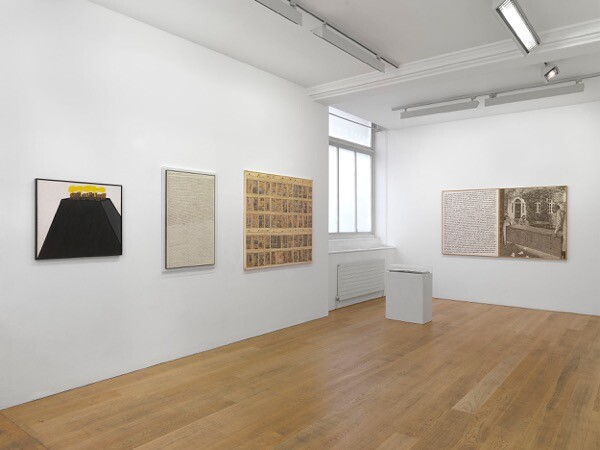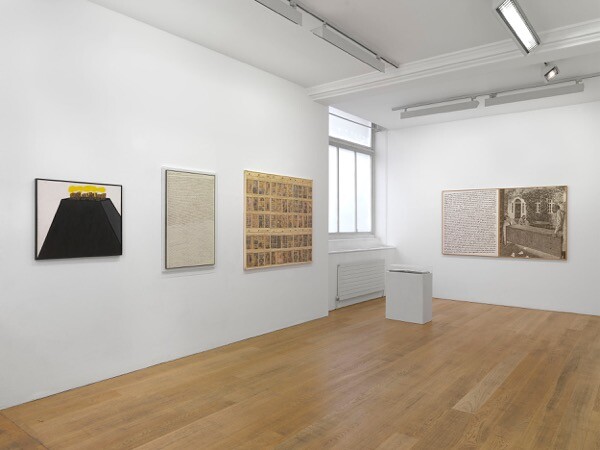Ian Breakwell was an iconic figure of London’s counter-culture in the 1960s and ’70s whose bleak and laconic text-works, films, performances, and photo-collages explored motifs of alienation, desire, and bathos. Always something more than a gallery artist, Breakwell worked with organizations such as the London Filmmakers’ Co-op (LFMC), the Artist Placement Group, and (in the 1980s) Channel 4 television in the UK.1 This exhibition centers on Breakwell’s early works from the 1960s and 1970s, and is organized in-house, between gallerist Anthony Reynolds and Jacqui Davies, who has produced works for Random Acts, Channel 4’s strand of experimental short films and videos. Given this backdrop, it seems odd that this exhibition does not include any of Breakwell’s moving-image works. This show is therefore partial—a small fragment rather than a full retrospective of his work during this period.
Thankfully, the two-dimensional works shown here do much to reveal and celebrate Breakwell’s convulsive and anarchic imagination. Most of the pieces are covered in dense webs of handwritten notes, so the exhibition demands a great deal of reading. The Kill (1969) is composed of two panels: on the right is a jaunty illustration, presumably sampled from a children’s storybook, of workmen delivering furniture to a bourgeois household; on the left panel a text recounts a gruesome tale of a murder and dismemberment. It’s a fearsome, angry piece, with the middle-class family cast as the complacent seat of modern violence. Description of a Picture (1968) is a text-based drawing on paper whose writing begins in the mode of humorless, self-referential conceptualism—“This picture is drawn on coloured inks on paper, forty inches high and twenty-five inches wide”—before slewing off in a garrulous, psychedelic description of scenes featuring Father Christmas, a clown, cats, dogs, children, and soldiers.
Breakwell’s text-based experiments follow the entropic collapse of language earlier explored in Lettrism, Fluxus, and Happenings. This impulse is best seen in the series of Unword performances he made between 1969 and 1970 (with fellow artists John Hilliard and Mike Leggett), in which Breakwell tore through an installation of large sheets of paper with words scrawled across them as part of a multi-media environment. These performances are documented here in a large, black-and-white photograph (Unword, 1969), and in Him Her (1971), a photo-montage with handwriting on paper (the work also includes a pornographic photograph of a woman and a story of an erotic encounter). A key work of the 1960s British underground, Unword brought together elements from London’s counter-cultural performance scenes, the anti-monumental sculptural actions explored by students at St Martin’s School of Art (Bruce McLean, Richard Long, and Gilbert and George emerged from this milieu), and the evolving expanded cinema scene centered around the LFMC. Unfortunately, it is impossible to make out the rich history of Unword as it is presented here, and the exhibition would have benefitted from a fuller statement from the gallery offering contextual information. A work that did give such background details was Episodes From Buffet Car News (1967), a documentation of an earlier multi-media theatre piece (Buffet Car News, 1967). A large silkscreen image shows actors on stage, and an accompanying wall-mounted text describes the original event: “a collage-performance incorporating taped sound, film, voices & physical movement, all within a box-like environment.”
Also exhibited was another work dealing with language, the rarely seen complete series of Breakwell’s 1974 Diary (1974), a large grid of framed works on paper, one for each day of the year. Each image features the same basic template: a close-cropped photograph of a man’s shirted arm, watch, and hand. The variable element includes a collage inserted into the face of the watch (Breakwell’s own lank visage, pornographic images of a woman, etc.), handwritten observations of London street life and train journeys, and stenciled words in upper case (“DOUBT BY DOUBT”; “DESIRE BY DESIRE”; “QUIVER BY QUIVER”). With its self-doubting slogans, haggard self-portraits, and observations of quotidian mishaps, the work is as much a record of Breakwell’s sense of mortality and loneliness as of the world around him. The piece suggests that Breakwell’s works are encounters with a world whose eggshell surface of civilization is forever on the verge of cracking.
For more on Breakwell’s APG work, see Claire Bishop, “Incidental People: APG and Community Arts” in Artificial Hells: Participatory Art and the Politics of Spectatorship (London: Verso Books, 2012), 163-191. Breakwell’s Continuous Diary films were broadcast on Channel 4 television in the UK in 1984, while Pluto Press put out a collection of his mordantly hilarious writings in 1986. See Ian Breakwell, Ian Breakwell’s diary, 1964-1985. (London: Pluto Press, 1986). For his film work, see Lux’s collection on http://lux.org.uk/collection/artists/ian-breakwell.










